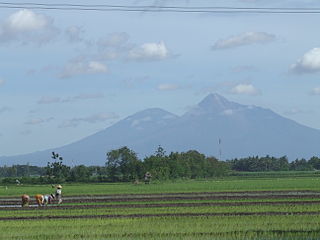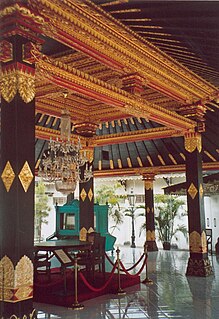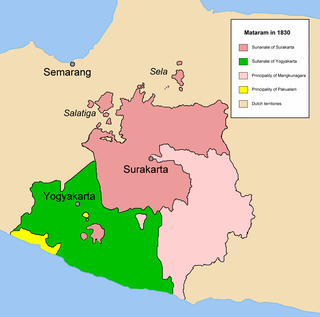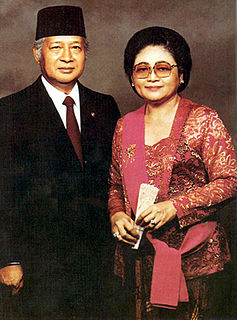
Central Java is a province of Indonesia. This province is located in the middle of the island of Java. Its administrative capital is Semarang. The province is bordered by West Java in the west, the Indian Ocean and the Special Region of Yogyakarta in the south, East Java in the east, and the Java Sea in the north. The area is 32,548 km², or around 28.94% of the total area of Java. The province of Central Java also includes the island of Nusakambangan in the south, and the Karimun Jawa Islands in the Java Sea. Central Java is also a cultural concept that includes the Special Region and city of Yogyakarta as well as the Province of Central Java. However, administratively the city and its surrounding regencies have formed a separate special region since Indonesian independence, administrated separately. Central Java is known as the "heart" of Javanese culture. Even so, in this province there are also other ethnic groups that have different cultures from the Javanese, such as the Sundanese in the border area with West Java. Besides there are also Chinese-Indonesians, Arabs-Indonesians and Indian-Indonesians scattered throughout the province.

Kraton or Keraton is the Javanese word for a royal palace. Its name is derived from ka-ratu-an which means the residence of ratu. Ratu is the traditional honorific title to refer the "ruler". In Java, the palace of a prince is called puro or dalem. The general word to designate a palace is istana, as in Indonesian and Malay.

Duchy of Pakualaman or simply Pakualaman is a minor Javanese princely state within the Sultanate of Yogyakarta. It was created in 1812 when Natakusuma was rewarded for helping the British quell the conflict in Yogyakarta in June 1812. It became the mirror-image of the Mangkunegaran principality in the territory of the Susuhunanate of Surakarta.

Mount Lawu, or Gunung Lawu, is a massive compound stratovolcano straddling the border between East Java and Central Java, Indonesia. The north side is deeply eroded and the eastern side contains parasitic crater lakes and parasitic cones. A fumarolic area is located on the south flank at 2,550 m. The only reported activity of Lawu took place in 1885, when rumblings and light volcanic ash falls were reported.

Dance in Indonesia reflects the country's diversity of ethnicities and cultures. There are more than 700 ethnic groups in Indonesia: Austronesian roots and Melanesian tribal forms are visible, and influences ranging from neighbouring Asian and even western styles through colonisation. Each ethnic group has its own dances: there are more than 3,000 original dance forms in Indonesia. The old traditions of dance and drama are being preserved in the many dance schools which flourish not only in the courts but also in the modern, government-run or supervised art academies.

Raden Ayu Siti Hartinah was the wife of the second Indonesian president, Suharto. She is usually known as Ibu Tien to Indonesians, but is also known as Siti Hartinah Soeharto.

Astana Giribangun,, is a mausoleum complex for the Suharto family of the former President of Indonesia. The mausoleum is located in Karang Bangun, Matesih, Karanganyar Regency, Central Java province. It is on the slopes of Mount Lawu, approximately 35 kilometres east of the town of Surakarta. The archaic Javanese prose title translates as "Palace of the risen mountain".
Yapto Soerjosoemarno, full name KRT. Yapto Soelistyo Soerjosoemarno, S.H, is an Indonesian politician who is known as the leader of Pemuda Pancasila, an organization of quasi-official political gangsters that supported the New Order military dictatorship of Soeharto, while also engaging in other lucrative but non-official criminal acts. Pemuda Pancasila played an important role in supporting Soeharto's military coup in 1965: they ran death squads for the Indonesian army, murdering thousands of alleged communists across the province of North Sumatra.
Asia has more monarchs than any other continent.
Mangkunegara IX is the current traditional ruler of the former state of Mangkunegaran, located in Java, Indonesia. He succeeded his father, Mangkunegara VIII, as Prince of Mangkunegaran on 3 September 1987. His full royal name is Kanjeng Gusti Pangeran Adipati Arya Mangku Negara.

Kanjeng Gusti Pangeran Adipati Arya Mangkunagara VIII was the last ruler of Mangkunegaran, in Java, in modern Indonesia. He experienced the Dutch colonial period and the beginning of Indonesia's independence. Mangkunegara VIII was the son of Mangkunegara VII, by Gusti Raden Ayu Retnaningrum, one of his secondary wives. The queen consort Gusti Kanjeng Ratu Timur had only one child, a daughter named Gusti Raden Ayu Siti Nurul Kusumawardhani.
Mangkunegara I, also known as Pangeran Sambernyawa, was the first ruler of Mangkunegaran in Java in the eighteenth century.

Surakarta Sunanate is a Javanese monarchy centred in the city of Surakarta, in the province of Central Java, Indonesia.
Sukotjo Tjokroatmodjo was an Indonesian historian, civil servant and retired Major general. He saw combat in the Indonesian War of Independence of 1945-1949. He later became assistant for international co-operation to the Minister of Defence, serving between 1978-1984. After retirement he was one of the vice-chairmen of Indonesia's veteran association, Legiun Veteran Republik Indonesia.

Prince Mangkunagara VII of a noble house of Solo was ruler of the Mangkunegaran Palace and lands in Surakarta in Central Java in Indonesia from 1916 to 1944, reigning during both World Wars. This first Scouting organization in Indonesia was established on the initiative of Sri Paduka Mangkunagara VII in 1916. Noto Soeroto served as his personal secretary.

Al-Wustho Mangkunegaran Mosque is a historic mosque located in the Central Javanese city of Surakarta, to the west of the Mangkunegaran Palace. The mosque is one of the three oldest mosques of Surakarta. Al-Wustho Mangkunegaran Mosque was inaugurated as a state mosque of the Mangkunegaran Palace.

The Legiun Pakualaman was an army corps of the Pakualaman princely state of Yogyakarta, formed in 1813 during the reign of Paku Alam I. The force was initially formed not only as a symbol of pride for the newly formed state, but also as a reserve force for the British, and later also the Dutch, colonial governments.














